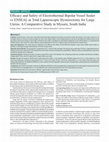Papers by Tohreen Fathima

Tubular adenomas are rare epithelial tumors of the breast. They are sometimes called “pure adenom... more Tubular adenomas are rare epithelial tumors of the breast. They are sometimes called “pure adenomas” because they tend not to show excessive epithelial hyperplasia and connective tissue growth. Only a few cases have been reported in the literature, mainly in young women of reproductive age. We hereby describe a case of tubular breast adenoma in a female who presented to us with a gradually enlarging breast lump. Clinically, a fibroadenoma was suspected and surgical excision was done. However, on histopathological examination a diagnosis of tubular adenoma was made. Pre-operative diagnosis is difficult because tubular adenoma is indistinguishable from a fibroadenoma on physical examination and breast imaging. Both radiologic as well as cytologic diagnosis performed prior to an excision biopsy may not be diagnostic. Surgical excision is necessary in order to reach a precise diagnosis and a definitive treatment. Although tubular adenoma is rare, it should always be considered in the di...

World Journal of Laparoscopic Surgery with DVD, 2021
Context: Hysterectomy is the most commonly performed gynecological procedure around the world. He... more Context: Hysterectomy is the most commonly performed gynecological procedure around the world. Hemostasis is of major concern in an enlarged uterus as chances of hemorrhage are more. New laparoscopic vessel sealing devices have been developed for laparoscopic tissue dissection and vessel sealing. In this study, an ALAN vessel sealer, an indigenous electrothermal bipolar vessel sealing device, is compared with ENSEAL device with respect to safety, efficacy, and perioperative outcomes in laparoscopic hysterectomy for a large uterus. Aims and objectives: This study aimed to determine the efficacy and safety of electrothermal bipolar vessel sealer (ALAN vessel sealer) vs ENSEAL in total laparoscopic hysterectomy (TLH) for a large uterus. Materials and methods: This prospective randomized case-control study included 100 women who underwent TLH for a large fibroid uterus. Of them, 50 women underwent TLH using ALAN vessel sealer, and the remaining 50 using ENSEAL. Efficacy, safety, and perioperative outcomes of both the groups were compared. Statistical analysis: Statistical analysis was done using SPSS version 16.0 software. For evaluating continuous variables and discrete variables, independent T-tests, and Chi-square tests, respectively, were used. Results: Duration of surgery in ALAN vessel sealer group was 56.90 ± 12.45 minutes and in ENSEAL group was 57.25 ± 13.54 minutes (p = 0.9) and mean blood loss in group A and group B was 111.40 ± 22.32 and 107.84 ± 20.33 mL, respectively (p = 0.4), both of the data were not statistically significant. No significant differences were noticed in the demographic characteristics, intraoperative, and postoperative complications between the two groups. Conclusions: The ALAN vessel sealer is safe and as efficient as ENSEAL in decreasing blood loss and operative time when laparoscopic hysterectomy is performed for an enlarged uterus. It is cost-effective and a promising instrument for TLH in developing countries.











Uploads
Papers by Tohreen Fathima